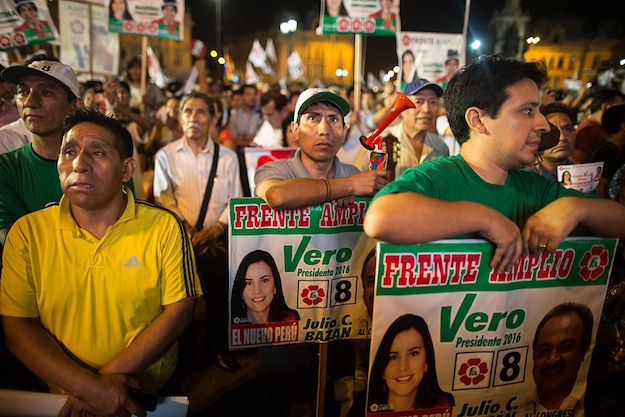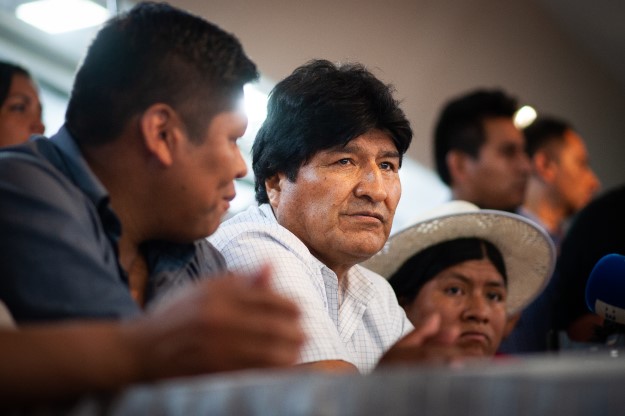LIMA, Peru — It was the perfect opening for the Peruvian left.
A deeply unpopular center-right president, Pedro Pablo Kuczynski, had just been forced to resign. The hard-right Popular Force party, which has an absolute majority in Congress and had driven his ouster, was riven by factional infighting between its leader, Keiko Fujimori, and her congressman brother, Kenji Fujimori.
But instead of seizing on the moment last April, Rogelio Tucto, a congressman from the socialistic Broad Front, an alliance of tiny left-wing parties, decided to call for the liberation of the jailed former leader of the Maoist Shining Path terrorist group, Abimael Guzmán.
The morality and legality of freeing Peru’s most reviled man, responsible for launching one of Latin America‘s most savage internal conflicts, might seem questionable enough: according to Peru’s official truth and reconciliation report, the Shining Path was directly responsible for 54 percent of the conflict’s 69,280 deaths.
But politically, the move was nothing short of kamikaze.
Tucto’s farfetched demand, purportedly in the interests of national “reconciliation,” was immediately condemned by virtually the entire ideological spectrum, including many Broad Front members.
It also shone a light on the Peruvian left’s long-running disunity, marginalization and inability to actually take power, even as most of its neighboring countries have seen the rise in recent years of leftist governments of various stripes, from social democracy to the autocratic populism of Bolivarian socialism.
Analysts point to various factors to explain the weakness of the Peruvian left.
“There’s no getting away from our recent history,” said Anthony Medina Rivas Plata, a political scientist at Arequipa’s Catholic University of Saint Mary. “That has put the left here at an even greater handicap than in other countries.”
The most obvious is the grim legacy of Shining Path, which Fujimoristas still frequently use politically, accusing even impeccably democratic left-wing critics of being “terrucos,” the Quechua word for terrorist.
Then there are the painful memories of the 1968-1975 regime of General Juan Velasco, unique among the South American dictatorships of the time for being left-wing rather than conservative. It remains principally remembered for a deeply controversial agrarian reform that turned haciendas into worker-owner cooperatives, and was blamed for falling agricultural output.
On top of that, most Peruvians over the age of 40 remain traumatized by Alan García’s catastrophic 1985-1990 presidency, arguably the last time Peru had a genuinely left-wing government. After nationalizing banks and imposing tariffs, his government ended with hyperinflation of more than 10,000 percent and Shining Path all but besieging Lima.
That trio of factors also allowed Garcia’s conservative successor Alberto Fujimori to usher in what Harvard political scientist Stephen Levitsky has called the “Lima consensus,” a broad national acceptation of deregulation, privatization and free trade.
Arturo Maldonado, a political scientist at the Pontifical Catholic University of Peru, describes Fujimori’s legacy as “anti-politics,” in which supposedly non-ideological technocrats are tasked with managing Peru’s booming capitalist economy.
“The average Peruvian voter is a moderate, with a preference for the right, and above all for the free market,” added Maldonado. “The left really has no alternative paradigm.”
Layered on top of that historical handicap is Peru’s electoral Balkanization, with most political parties being weak and ephemeral vehicles for the ambitions of charismatic – and in some cases not-so-charismatic – leaders.
That means career politicians of all stripes, particularly members of Congress, regularly have to swap parties to have a chance of staying in office – which, in turn, weakens the ideological identity of most parties and leads to the dispersal of like-minded politicians. This tendency has particularly hit Peru’s left.
Of course, Ollanta Humala’s 2011-2016 presidency might be regarded as an exception to the rule. After running in 2006 on an overtly chavista platform, the former army officer tacked hard to the middle and was elected on a center-left platform five years later.
Nevertheless, his victory was based in large part on the visceral opposition to his second-round opponent Keiko Fujimori. Once in power, Humala eventually moderated his position further – or, as some of his erstwhile supporters would have it, was “captured” by Lima’s business elite.
But there is no escaping the Peruvian left’s fratricidal tendencies and unerring ability to shoot itself in the foot.
The most significant recent example is the fate of Verónika Mendoza, the youthful Broad Front candidate who narrowly missed out on a place in the 2016 presidential runoff vote.
The Cusco-born daughter of a French mother who had participated in student protests in 1968, Mendoza, a member of Congress who had split from Humala’s Nationalist party, won nearly 19 percent of the popular vote. She was strong enough to pull the Broad Front in her wake; the party took 20 of the single-chamber Congress’s 130 seats.
That result was a generational high-water mark for the left. Given that Mendoza was just 35, it appeared the Broad Front had an excellent foundation from which to compete in the 2021 elections and beyond.
Instead, the alliance split down the middle within months. Ten lawmakers allied with Mendoza launched a new parliamentary block called New Peru, and bitterly denounced the alleged authoritarianism of Marco Arana, leader of the Land and Freedom party, which had allowed its electoral registration to be used by the Broad Front.
Now, Mendoza is scrambling to collect the hundreds of thousands of signatures needed to register her new party so she can run in 2021. She has also been hamstrung by her failure to clearly denounce the abuses of Nicolás Maduro’s regime in Venezuela.
“She probably gets it regarding Venezuela,” said Maldonado. “But she can’t afford to alienate the people who organize for her in the provinces, who are trying to get those signatures.”
On the center left, Alfredo Barnechea, the candidate of Popular Action, one of Peru’s few political parties with a genuine tradition and ideological coherence, also wants to improve on his fourth-place in the 2016 presidential race.
Yet his party is tiny, with just five members of Congress and no presence in large parts of the country. Barnechea, a former director of external relations at the Inter-American Development Bank, will also have to overcome the electoral handicap of being a member of Lima’s white elite.
“People are so angry about Odebrecht,” said Medina Rivas Plata, referring to the corruption scandal centered on the Brazilian construction conglomerate. “There is a space on the left that is wide open. It’s possible the people will go for the most radical option. But it’s impossible to predict what will happen in 2021.”
Yet one thing appears certain: If the Broad Front, New Peru, Popular Action and several other more radical leftist candidates do not find a way to unite, the chances of the left finally taking power in Peru three years from now, will, once again, remain limited.
—
Tegel is a journalist based in Lima







